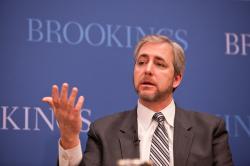Infrastructure enables global trade, powers businesses, connects workers to their jobs, creates new opportunities for struggling communities, and protects America from an unpredictable natural environment. However, these critical systems are in a state of disrepair.
Aging bridges, congested roads, outmoded storm and drinking water systems, and deteriorating public buildings are just a few examples. While many of these deficiencies are readily visible to the naked eye, the underlying problems that keep us from fixing them are not. Behind the scenes, the procurement processes that guide the way the public sector plans, finances, builds, manages, and operates these systems are in an even greater state of disrepair than the assets themselves.
Today’s leaders aren’t just stuck repairing antiquated roads that were designed to meet America’s needs in the 1940s, they are also burdened with procurement systems designed for a less connected and slower paced world. Outdated laws, unsupportive regulatory frameworks, non-existent standardization, poor coordination, and even the lack of commonly understood terminology continue to hinder progress. Government and private sector stakeholders, as well as the public who eventually benefits from these projects, bear the costs of these antiquated processes through delayed projects, sub-optimal risk allocation, and wasted time.
Despite the daunting challenge of reforming America’s infrastructure procurement systems, there is a growing body of best practices emerging from leaders in local, state, and even the federal government. While many of these initiatives remain isolated in their own silos or regions, the interest among policymakers and private sector leaders in finding replicable models and new practices is incredibly high.
Recently the Brookings Metropolitan Policy Program hosted the first of a series of workshops, with support from insurance company AIG, focused on identifying the biggest challenges and opportunities for America’s procurement system for infrastructure and the built environment. Leveraging real world experience from practitioners in government, finance, insurance, law, and construction, we identified the top four opportunities for smart infrastructure reform.
1. The details matter, but infrastructure projects require visionary leadership
Participants identified dozens of small technical fixes that can help address America’s infrastructure challenges. However, the group agreed that America’s failure to establish a strategic vision for infrastructure development was the most pressing challenge in the space. While “vision” is a relatively broad term, the specific traits identified by the group were the ability to prioritize the highest impact projects and to maintain flexibility in the face of a continually evolving procurement environment.
While the United States is a world leader in engineering and design, we continue to struggle in prioritizing infrastructure projects that have the highest return for our businesses, communities, and environment. Much of this can be attributed to the continuing desire of politicians to pick projects easily touted in the next election.
Creating a defined infrastructure pipeline based on quantifiable public goals, like the United Kingdom’s National Infrastructure Plan or the Building a New Chicago initiative, is a key step. These consensus-driven planning processes give leaders a framework and process to achieve the economic, environmental, and equity needs that infrastructure actually delivers by soliciting public input along with robust economic analysis. Fundamentally, a strong prioritization process both creates and validates a vision that a governor, mayor, or other leader can move forward.
Shepherding a vision into reality is always challenging, particularly in a constantly evolving political, technical, and financial environment. Policymakers and the public are used to thinking of a project moving from planning, to design, to finance, to construction, and finally delivery. However, today’s increasingly complex and complicated projects rarely progress in a linear fashion.
Unexpected factors, ranging from a lawsuit challenging a toll for the Elizabeth River tunnel in Virginia to the immense technical challenges of extricating a broken boring machine stuck under Seattle, demonstrate how quickly the assumptions underlying a project can be altered. Leaders need to remain nimble enough to re-evaluate and retool different aspects of the project to fit the realities on the ground, while maintaining their overall vision. This requires a willingness to revisit or renegotiate contracts, engage with the public, and creatively pursue new opportunities as they emerge.
2. Public Sector Expertise and Capacity Underpin Successful Projects
While establishing and maintaining vision from top-level leadership is critical, building the expertise and capacity of public sector employees working on the more technical or day-to-day issues is also essential. These engineering, budgeting, and procurement professionals face enormous pressures to deliver increasingly complicated infrastructure projects faster and cheaper under unprecedented levels of media and public scrutiny.
Consequently, they are being asked to develop skills beyond basic costing, engineering, and bid solicitation skills required of previous generations of public servants. Assembling a public sector team that excels not only in those areas, but also structured finance, program and risk management, law, policy, communications, and risk sharing is increasingly a priority. However, bridging this skill gap is no small challenge. While some of these issues can be addressed by hiring outside consultants, it requires building up both internal capacity to execute complex projects and a cultural shift towards greater flexibility, customer service, and stakeholder engagement.
Creating this kind of project expertise and institutional culture usually involves the creation and sustained support of a dedicated team tasked with developing financially and technically complicated projects. These teams can live inside a department, such as a transportation office, or may be generalists under a mayor or governor’s office. Examples of these types of these units can be found at both the state level, notably Virginia’s Office of Public-Private Partnerships, and at the city level in places like Los Angeles and Chicago. The Obama administration is also creating the Build America Transportation Investment Center, a coordination unit at the U.S. Department of Transportation that will help localities with innovative finance tools.
3. The Smart use of Standardization Speeds Project Delivery
According to one of our participants, developing infrastructure projects in the United States is like working in fifty different countries. Each state has its own unique procurement rules, institutional governance, legal requirements, financial tools, and bidding procedures. In some states the process gets even more complicated when working in particular localities, like New York and Chicago, which have their own specific practices.
This fragmented approach drives up costs for the private sector as they must learn how navigate a new procurement environment in every place they do business. Furthermore, it limits the public sector’s ability to adapt best practices from their peers, to effectively work across institutional silos, and slows progress on the projects they want delivered. Finding areas where standardization speeds up and improves the procurement process, without limiting creativity, is an essential part of fixing America’s antiquated infrastructure.
Considering the wide variety of public, private, and community stakeholders involved in an infrastructure project, even the small inconvenience of learning how to fill out a new permitting document for each level of government or managing different approval schedules for an environmental review and a financing agency can add significant time and cost to project development.
Basic steps like maintaining common application forms, centrally posting documents on a single website, and creating a consistent submission and review calendars both horizontally across public agencies and vertically between levels of government can significantly improve procurement.
Notably, California is pursuing this kind of standardization throughout its clean energy financing and permitting processes by bringing its dozen of existing programs under the management of their newly created Green Bank. New York Works is also taking similar steps to align approval schedules and paperwork in the state’s multiple transportation and water agencies.
While standardized application materials and schedules can improve procurement for all stakeholders, it is important to understand areas that benefit from a less rigid approach. This is particularly true for the term sheets and contracts that specifically lay out the roles and responsibilities that the private and public sector choose to take. As each project has its own unique risks and rewards, excessive standardization can limit the ability of both sides to come up with project-specific solutions that can deliver a better project for everybody. For example, formulaic requirements around insurance underwriting might limit the ability of a contractor to find a better way to share liability risk with other partners.
4. Collaboration between the Public and Private Sector Delivers Better Projects
The majority of public sector procurement is built to manage projects through conflict. Everything from the initiation of a deal through lowest cost bidding, to project oversight and monitoring, to litigation in the case of contract disagreements, is designed to pit the public and private sector against one another in the hopes of keeping the procurement on track.
While this system effectively addresses important public concerns around fairness, cost management, and responsibility, it can lead to an environment where partners are unable to trust each other, opportunities for efficient risk transfer are missed, and projects fail to live up to their fullest potential. In many cases, each partner is spending more time trying to outwit the other or to reduce legal risk, instead of working to create a better infrastructure project.
Fortunately, there are smart ways to create a more balanced process, which preserve the benefits of competition while opening the door to more collaboration.
The first step is to run pre-selection workshops that allow any interested private sector firm to learn about a prospective infrastructure project and provide initial feedback. These open meetings give both the public and private sector an opportunity to shape the project, without a set obligation from either side of the table. Virginia’s Office of Public-Private Partnerships regularly runs these types of sessions for their projects.
Starting a project off with a request for qualifications (RFQ), before running a request for proposals (RFP) also generates more opportunities to build a better project. A RFQ is simply a way for the public sector to ask the private sector what skills, capabilities, staffing, and other values they bring to the project, before asking them to prepare a detailed proposal of exactly how they would approach the project. This early sorting tool helps the public sector weed out under qualified bidders and helps private firms avoid investing time and money into a proposal that has a low probability of winning. Notably, Pennsylvania used an RFQ as a starting point for their rapid bridge replacement project.
Finally, pre-development agreements can be used after an RFQ to engage a contractor as a full partner in developing an infrastructure project. These agreements allow a pre-qualified bidder to work directly with the public sector on the preliminary design of the project, including engineering and financial details, before fully entering into a contract to deliver the asset. In exchange for the private sector’s up front contributions, they receive a reduced or deferred fee for their work as well as the right of first refusal when the project moves into full procurement. This approach gives both sides an opportunity to explore ways to share project risks and opportunities, before committing to a full partnership.
Conclusion
In many ways, it is easier to build a state of the art water treatment plant or court house than it is to build a state of the art infrastructure procurement system. Slow moving bureaucracies, siloed agencies, ingrained institutional habits, and outdated laws, make change difficult. Despite these challenges, many state and local governments, as well as some federal agencies, are moving forward with new policies and laws that are rewriting America’s procurement playbook.
Some of these efforts are modest and incremental, including efforts around creating standardized application materials in New York. Others are bold and national in scope, like a national investment center at the U.S. Department of Transportation. Regardless of their scale and ambition, these efforts and many more are ripe for replication. As this series of workshops continues, Brookings, together with our private sector colleagues, intends to identify and push this growing body of best practices out into our national network of leading policymakers and practitioners.


